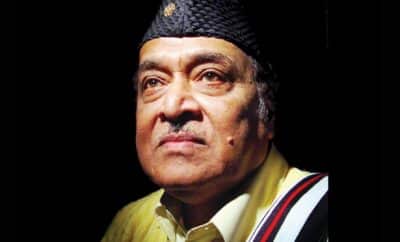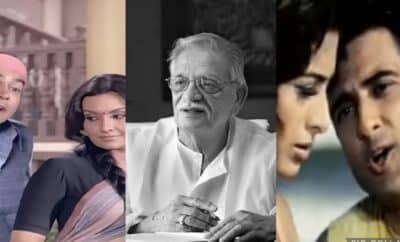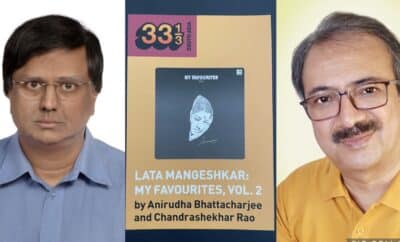Collections
Lata Mangeshkar and the Magical Batons
Lata Mangeshkar is a phenomenon that occurs once in a millennium. A lot has been said and written on her singing proficiency and a lot still remains. Due to her astounding capabilities and enormous potential, she was the first choice of most of the music directors of the golden era.
While writing on Lataji’s one milestone song from each of the 7 decades of her active career (Didi’s Decennial Diamonds – Lata Mangeshkar and the 7 Decades) on the occasion of her 90th birthday, the work of many music directors who held important place in her career could naturally not be addressed considering the theme.
Here is an attempt to briefly touch upon a few such music directors and their work with Lataji. The compositions of all these stalwarts played an important role in Lataji’s musical journey and a few of them undoubtedly deserve a credit for contributing to her career progression at least in her initial days – there would not be two ways about this!
Anil Biswas – Jaa Main Tose Naahi Boloon
Anil Biswas, rightly known as the Bheeshma Pitaamah or the patriarch of Hindi Film Music, was one of the most talented music directors and a founder of the Lata Era alongside Ghulam Haider and Khemchand Prakash. He has a major contribution in transforming Noor-Jehan-esque Lata in the initial days to “the Lata Mangeshkar”. Lataji has also often highlighted his role as a mentor who taught her numerous playback and microphone techniques.
The mellifluous association between Anilda and Lataji was at its peak in late ‘40s and early ‘50s. I have however chosen the song “Jaa Main Tose Naahi Boloon” from Sautela Bhai (1962). In my opinion, it is one of the best compositions by Anilda and one of the best classical numbers ever heard in Hindi films.
The song, a mujraa on the screen, is composed primarily in raag Adana in thumri style. Orchestration comprises very few basic instruments befitting a mujraa – sarangi, tabla and harmonium. Aalaaps, taans, murkis and khatkaas sprinkled all over however make up for the sparse orchestral landscape.
And how stunningly the empress has rendered it despite it being inherently challenging and demanding! In addition to the basic elements of a classical composition (aalaaps, taans etc.), the song also demands a nakhraa to express the pretended fury coupled with playful allurement. Her rendition highlights not only her flawless classical proficiency, but also her mastery over playback singing through the nakhraa that she has expressed. Just look at her “hmm” in the second antaraa, for example!
C. Ramchandra – Ye Zindagi Usi Ki Hai
C. Ramchandra – Ramchandra Chitalkar – popularly known as Anna was a renowned music director of golden era, who is always remembered for numerous musical gems that he composed mainly from late ‘40s to early ‘60s. Trendsetter as he was, besides composing a good deal of exemplary tunes based on Indian classical music (many based on his favourite raag Bageshri), he experimented a lot also with western music. His tunes, albeit devoid of complexities unlike some of his peers, were transformed into masterpieces by his unique subtle touches.
Even the young generation, who might not have even heard of Anna, is sure to be acquainted with his timeless patriotic composition “Aye mere watan ke logon” – which has been an anthem of patriotism for more than 5 decades.
Lataji and Anna had a very special and successful collaboration for over a decade. The duo created many unforgettable musical jewels until their tuneful rapport came to an end in late ‘50s – thanks to the personal differences between them. Anna, though famous for simple yet very sweet and melodious tunes, would always come out with magical tunes when it came to Lataji. Reciprocally, Lataji would always adorn his tunes with an extra pinch of sugar and emotional intimacy. As if the voice and the tunes were made for each other!
Anarkali (1953) was one of Anna’s major hits. Particularly, the song “Ye zindagi usiki hai” that has a happy and a sad version, has always left an unforgettable imprint on the minds of music lovers. It is said that the tune, predominantly in raag Bhimpalas, is inspired from a famous Marathi natya-geet “Murtimant bhiti ubhi majsamor rahili”. The song was written by Rajinder Krishan.
In the happy version, Anarkali is joyously expressing her love. Lataji’s jovial tone coupled with the Sitar dominated orchestration clearly expresses her merry mind. As against this, slight reduction in the pace, suitable modifications in the orchestration and Lataji’s voice soaked in the sentiments of Anarkali who sees her death standing right in front; completely set the tone in the sad version. It culminates into the valedictory “alvida” repeated in gradually rising notes depicting Anarkali’s rising despair when vanishing behind the bricks. How flawlessly Lataji’s voice embraces the high notes, without even slightly distorting the tone!
S.D. Burman – Mora Gora Ang Lai Le
S.D. Burman, popularly known as Dada Burman, was one of the most venerable and influential music directors in the film industry. Mainly with a perfect blend of classical and folk music, he composed many ever-green songs for Hindi films. His ability to enter the situation of the song while composing was well known and that’s why his songs sound full of life after so many years even today.
Lataji was always his first choice and a crucial element of his music. He is reported to have said that he could create memorable songs just with a tabla, a harmonium and Lata. Lataji also always held Dada Burman in utmost reverence.
Their euphonious association lasted throughout Dada Burman’s career, except for a rift of 3-4 years between them in late ‘50s. The two titans eventually mended the rift when Dada Burman’s son wanted Lataji to lend her voice to his first film. Lataji was thus back to the Burman camp and “Mora gora ang lai le” from Bandini (1963) was the first song that Lataji recorded for Dada Burman after the differences were patched up.
The song, written and composed in the style of Krishna Bhajan, depicts the awakening of love in the heart of a naïve rural girl. She wants to meet her lover clandestinely at an unearthly hour and she can’t do that for obvious reasons! She is whispering her feelings to herself in the backyard. Lataji has so precisely stepped into the shoes of the girl and adorably crooned the song in her honeyed voice throughout – the Lata magic! The finespun and enchanting orchestration concordant with Dada Burman’s minimalistic approach leaves sufficient ground for Lataji and she has made the most of it. The swaying beats of tabla are simply amazing!
The song has another historical importance – it is Gulzar’s first film song – so different and simple as compared to his unique style that he developed later – yet full of unique concepts and images! One can clearly notice his potential to draw word sketches in his very first song!
https://www.youtube.com/watch?v=IDZbnsU3lP0
Salil Chowdhury – Aaja Re Pardesi
Salil Chowdhury – Salilda – was a true genius in Hindi and Bangla film industry. His offbeat tunes have always been leaving the music lovers in astonishment. In his career spanning over 4 decades, he composed music primarily for Hindi, Bengali and Malayalam films. With his inventive and innovative approach, he experimented a lot with folk and western music. He also composed quite a few mind blowing classical tunes. Though his work might be much less in quantity as compared to his peers, he indisputably was a class apart in terms of quality.
The mellisonant association between Salilda and Lataji was an unmatched alliance of two musical masterminds who were perfectly in “tune” with each other. Lataji reigned supreme over his Hindi film music repertoire and played a major role in his Bengali compositions too. Salilda referred to Lataji as a living miracle and an integral part of his music. Lataji has also many a time acknowledged his contribution in her musical journey and said that she enjoyed singing his complex and unconventional tunes a lot.
Madhumati (1958) was Salilda’s first major Hindi hit and he got the Filmfare best composer award for the film. Lataji dominated the soundtrack of the film; and amongst all her cloyingly sweet numbers, the immortal theme song penned by Shailendra “Aaja re pardesi” became the biggest hit. It fetched Lataji her first Filmfare best playback singer award. Salilda has created a magic without a heavy orchestration, just with the help of his distinct touches. The song is simply outstanding in terms of everything – picturisation (look at it keeping in mind the technology that was available 6 decades ago), composition studded with Salilda’s distinct touches, lyrics effectively expressing the pain of a perpetual wait coupled with the perseverant hope; and last but certainly not the least, Lataji’s spellbinding and inimitable rendition.
Lataji seldom did suggest any modifications or changes in the tunes to the music director. However, based on her suggestion (which was a rare incident), Salilda started the anatra of this song with Pancham; and it added an appealing touch to the entire song.
Salilda had once remarked that the tiny-looking singer (Lataji) looked like a tall giant while singing. Wouldn’t she have surely looked like one, occupying the entire recording studio with her ethereal voice and aura while recording this song, in particular?
The song mainly based on raag Bageshri has always remained in the list of Lataji’s personal favourites and has not lost even a bit of its appeal even after 6 decades.
Hemant Kumar – Kuchh Dil Ne Kaha
Hemanta Mukherjee – Hemant Kumar – a celebrated music director of Hindi and Bengali film industry and a playback singer with a unique, deep and haunting voice – certainly deserves a mention in this league. Simplicity was the characteristic feature and at the same time the appealing factor of his compositions. He was also a popular artist of Ravindra Sangeet, and the influence can be clearly seen on many of his tunes.
Hemantda’s association with Lataji started right from his debut movie as a composer Anandmath (1952), for which Lataji recorded the famous patriotic composition “Vande mataram” under his music direction for the first time. It strengthened with the grand success of his Lata-dominated soundtrack of Nagin (1954), which gave both a great recognition. They shared a lot of respect for each other throughout Hemantda’s career.
As soft and tranquil songs were Hemantda’s speciality, there could have been no better choice than Lataji for him. Many of the songs that Lataji has sung for him linger between happiness and pathos, and sound mystical and captivating. Anupama (1966) was an album full of such songs, with “Kuchh dil ne kaha” and “Dheere dheere machal aye dil-e-beqarar” topping the list.
“Kuchh dil ne kaha” is kind of a conversation that a lone girl introverted by the circumstances is having with herself. She is broken and deeply hurt within; but has been wearing a mask of happiness for others – “Dil ki tasalli ke liye jhooti chamak, jhoota nikhar; Jeevan to soona hi raha, sab samjhe aai hai bahaar” – how precisely has Kaifi Azmi captured her feelings! She is in love with someone, but is hesitating from expressing it out of the fear of imperilment of the already flimsy relationship with her father – “Leta hai dil angdaaiyan, is dil ko samjhaye koi; armaan na aaknkhe khol de, ruswa na ho jaye koi!” – accurate expression of her feelings by Kaifi Azmi again!
Lataji has meticulously captured the essence of the girl’s emotions effectively penned by Kaifi Azmi and the Hemantda’s mystical, haunting composition supporting the same. As the girl is speaking to herself, Lataji just hums the song right form the first note and retains the tone immaculately till the end, without compromising on any note or pronunciation. This is one of the songs substantiating Lataji’s friendship with the microphone – her skill to use the microphone optimally and effectively.
The song leaves you spell bound. You listen to it once, and you are surely tempted to listen to it again and again.
Whether all these stalwarts were instrumental in shaping up Lataji’s career or it was vice versa, is a chicken and egg question. For us, however, the fact remains that their combined work has created an eternal treasure of ageless music, which is an altogether separate stream of music in itself and is now no less than a part of India’s rich heritage.
By the way, I heard you whispering some names that haven’t found place here. Wait… the next part covering some more important musical figures of the golden era is in making… ☺




Manoj Mishra
October 18, 2019 at 10:36 pm
Great writeup. Thanks.
Yogesh Kale
October 19, 2019 at 7:09 am
Thanks a lot, Manoj Ji ??
Rajan Nebhnani
October 19, 2019 at 7:54 am
हजारों मोतियों में से कुछ मोती चुनना बहुत ही सराहनीय है. आर्टिकल अच्छा लिखा है, बधाई के पात्र हैं आप ????
Yogesh Kale
October 19, 2019 at 11:35 am
बहुत धन्यवाद, राजन जी ?
Ajay Poundarik
October 19, 2019 at 6:20 pm
Lata Mangeshkar have rendered some fabulous songs under Shankar-Jaikishan, Madan Mohan, Laxmikant-Pyarelal etc. Surprised to see missing the above names.
Unexampled, Unparalleled League
LATA MANGESHKAR and LAXMIKANT-PYARELAL
https://bit.ly/2sgKvry
Yogesh Kale
October 19, 2019 at 6:43 pm
Ajay ji, hope you’ve read the write up completely.. I’ve clearly mentioned in the last para that next part is in making and it would cover the work of a few other MDs.. Also, there’s a logic in selecting MDs for the 1st part..
SJ were covered in the very first write up in this series, a link to which is there in this write up..
Sandeep
October 22, 2019 at 7:34 pm
Waiting for the next part. This one was engaging and informative. Fun to read too…
Yogesh Kale
October 22, 2019 at 11:12 pm
Thanks a lot, Sandeep ji ??
This certainly encourages me to complete the next part very soon..
Pingback: Carnival of Blogs on Golden Era of Hindi Film Music – October, 2019 – The world is too small? or Is it?
Rahul Bhagwanrao Muli
February 1, 2020 at 8:21 am
Great write up choosing only one song from a long list of each composer is a very tricky affair. But I am delighted to find kuchh Dil ne kaha & Mora gora ang , such sonorous & soft melodies!
Yogesh Kale
February 1, 2020 at 11:45 am
Thanks, Rahul ji!